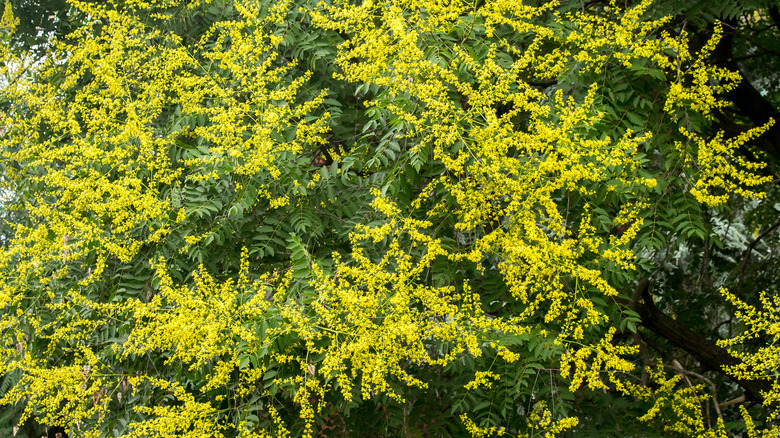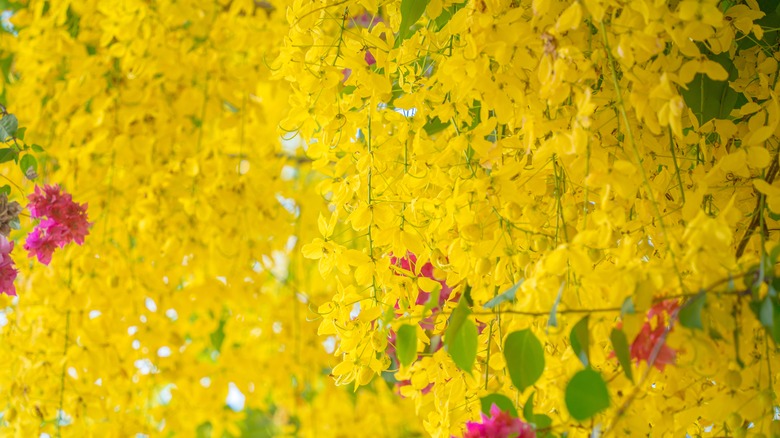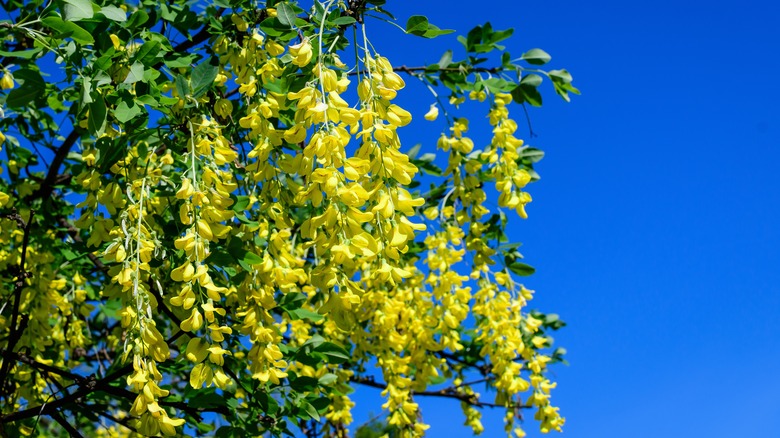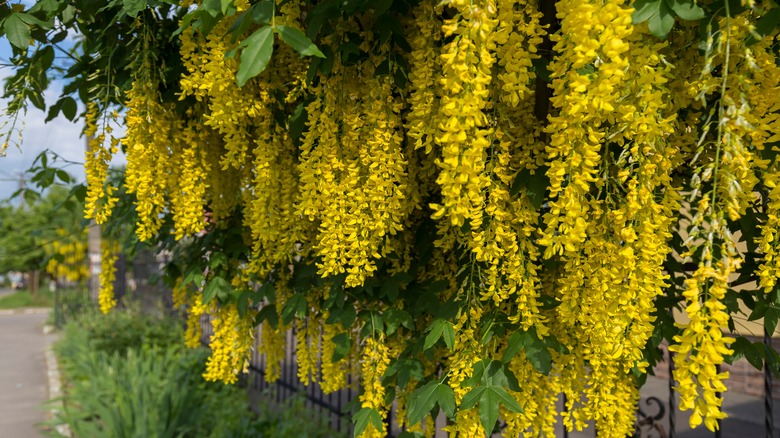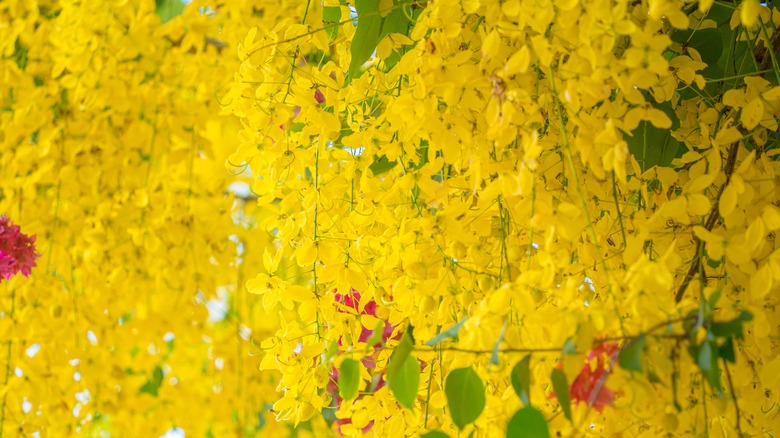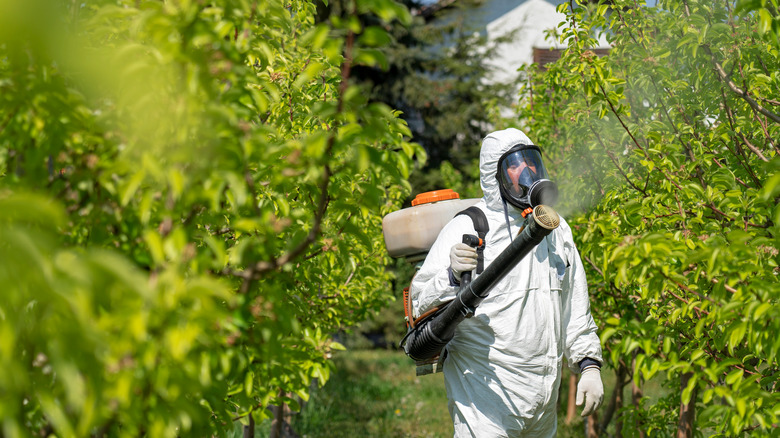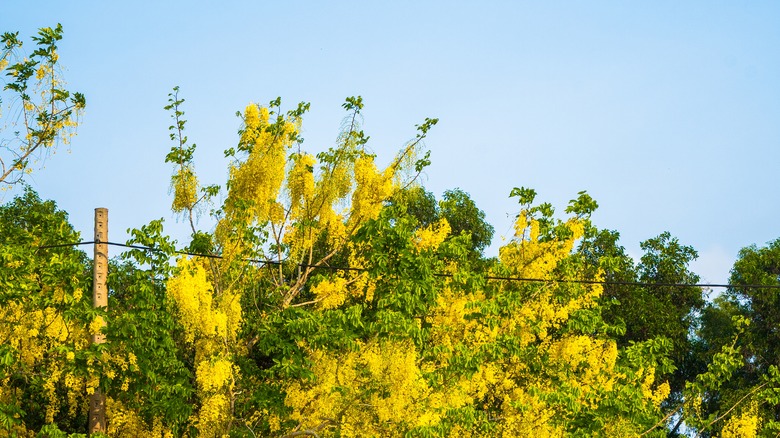How To Successfully Grow A Golden Rain Tree
Let's talk gold but in tree form. The golden rain tree (Koelreuteria paniculata) is a large and lovely yellow flower blooming shade tree. If you have ever come across a medium-sized tree that had vase-like flowers that bloom in the mid-summer, you have most probably encountered a golden rain tree (at least we would bet on it!). Since this mid-size ornamental tree did not make our list of 15 small trees that will not overtake your yard, we decided to do a whole piece for this golden baby.
Gardening Know How writes that the golden rain tree is an attractive plant that tends to grow up to 25 to 40 feet tall and can survive in USDA hardiness zones 5 through 9. Monrovia adds that this tree was planted in Chinese cemeteries to indicate the burial sites of high-ranking officials, but you don't have to wait till you lose a loved one to plant this tree; simply grow one or two in your backyard for shade. We cannot wait to teach you just how to grow and care for them!
How to use a golden rain tree in garden
There are a plethora of uses for the golden rain tree in your garden and even your yard. First off, we would like to point out the fact that the roots of the golden rain tree can help secure soil in place and protect against erosion whenever it floods or rains cats and dogs, says Mr. Tree Services. This way, you get to keep your other plants and vegetables, which otherwise have weak roots not as firmly in place. Furthermore, Love to Know writes that this plant is highly adaptive and can tolerate multiple harsh conditions, and is the perfect low-maintenance tree.
Another great use of the golden rain tree in a garden is that it is a very efficient tree for providing shade. It can take the bulk of the work off your hands for the other plants in your garden that require shade to thrive, or will not grow efficiently if exposed to too much sun, says How Stuff Works.
How to grow a golden rain tree
The golden rain tree is what most advertisers will probably call a zero-stress tree. Its planting methods are quite basic, but we have also gotten some insider hacks for you. First thing's first, Tree Seed Online says that you should soak your seeds in hot water for 24 hours before you decide to plant them. After that, the next day, you can go ahead and choose a planting spot, ensuring you can get enough sunlight as well as partial shade in the ideal location.
Once you have done so, please go ahead to check that you have rich and moist well-draining soil because Gardening Know How writes that this tree grows well in flooded conditions. Once you have all that ready, dig a hole and place the seedlings in the ground. Cover with compost, soil, and fertilizer. Water the trees regularly every day for six months and fertilize once a month for three years after planting, writes Plant Index.
How to care for a golden rain tree
Now that you own a golden rain tree (we do not care how big it is yet, you're a tree owner and we are proud of you!) you should know how to take care of it so it doesn't get infested by termites, or have unruly growth and it blooms so big it begins to droop on your house. Yes, none of these things sound good. Seriously, do not neglect your tree!
The first thing to do is to ensure that you consistently check the branches for insects. If your tree gets infested, well, the bark becomes not-so-sturdy and your tree could die — sad way to put it but that's the reality. To fix this issue, whenever you find insects in the tree, spray with horticultural oil so that the insects in the branches die instead of your tree (via Plant Index). It's a literal kill or be killed situation here.
Then on to the basics of sun and water, which all plants need to grow and live and thrive; the golden rain tree requires only about six hours of full sunlight daily. As for watering, just be regular and that's it. Lastly, for fertilizing, we said earlier to do this once a month for its first three years, and then you can space the frequency after three years. Prune all the dead growth and branches that have gone astray to prevent any form of damage, writes Garden Guides.
Varieties of the golden rain tree
The golden rain tree comes in three major varieties and one of them is more scarce than the others. For starters, there is the Fastigatia, which might just be the fairest, no we mean the rarest of them all (we do not discriminate between trees). There is also the type that shares a name with September. The last variety, which is called Stadher's Hill, might just be one of the most beautiful ornamental plants you have ever seen. Let's do a quick walk through.
- The Fastiaga (koelreuteria paniculata) is also known as the upright golden rain tree because it grows vertically and does not exactly spread out its branches horizontally. According to Beechwood Gardens, they can grow up to 30 feet tall!
- Just like you may have guessed, the September golden rain tree got its name because of its blooming season. According to Dave's Garden, it has quite a lot of greenery. Also, its bright yellow flowers come up in the middle of summer and are quite the scenery for the holidays.
- Lastly, Stadher's Hill, which might be the most colorful golden rain tree, is an ornamental tree that has red instead of the typical green seed pods, says Frontier Tree Service.
Is the golden rain tree toxic?
We opine that all responsible pet owners and parents should make sure to know the toxicity of a plant before deciding on growing it. If a plant is toxic and you ignorantly plant it, and it causes some damage, you could end up with some real and even legal problems on your hands. That being said, let us test the toxicity of the golden rain tree.
One would expect that a plant with such a lovely name would be non-toxic. Well, we did too. However, according to Pet Poison Helpline, the golden rain tree contains a toxin known as quinolizidine alkaloids and this can cause severe symptoms like vomiting, weakness, and more when ingested by pets or even humans. Additionally, in research carried out by Colorado State University, the immature seeds of the golden rain tree are very toxic to the following life forms: humans, horses, cattle, and dogs. So, if you are going to have one, ensure that the seeds are out of reach of your toddler, cats, and dogs. Stay safe!
How to repot a golden rain tree
Finally, if you are one of those types who like to plant their seedlings under intensive care and a watchful eye inside pots and indoors, this section is for you. Also, if you find it necessary, you can always pull one or two trees out of the ground and replant them elsewhere. The more the merrier, unless, of course, you have a small yard. Anyway, how exactly do you report a golden rain tree? Shall we get to it?
Great, so the first step is to choose a spot. The ideal specifications are areas that receive six hours of sunlight and rich, moist, well-draining soil. Then, to do the messy work: Take out all the seedlings you will be repotting, preferably in the winter or early spring. This is so that you have them ready before they begin to sprout new fresh leaves, says Garden Guides.
Finally, dig a hole, preferably 2 or 3 feet deep, and plant them horizontally in a mix of peat potting mix and well-drained soil, cover, and then you are good to go, writes Asking Lot.
